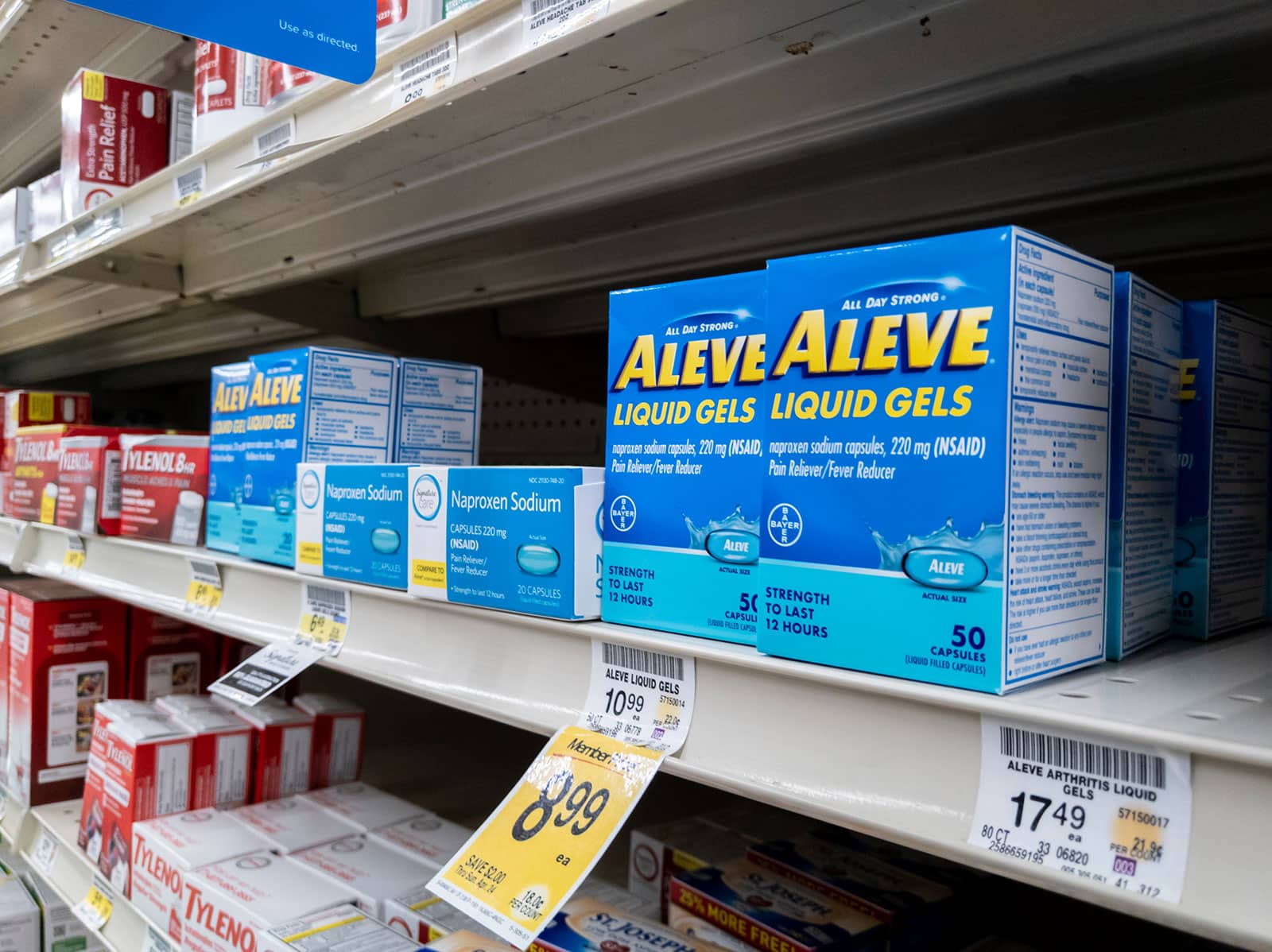A lot of people reach for over-the-counter medications like Aleve to manage pain from headaches, muscle aches, menstrual cramps, and even fever.
However, even the safest pain medications can be risky when combined with other drugs and chemicals.
For instance, the medication warns its users against mixing the drug with alcohol because it can lead to serious side effects on various organs, including the stomach and liver.
In this article, we’ll take a closer look at the interaction between Aleve and alcohol, including how they affect the body, safer alternatives, and when to seek medical help. Let’s dive right in!
What Is Aleve?
Aleve is a brand name for a popular pain relief medication that contains naproxen sodium as its active ingredient.
Naproxen is classified as a non-steroidal anti-inflammatory drug, also known as “NSAID”, which is a large class of medications commonly used to provide pain relief and reduce inflammation.
Like many drugs from this class, the most popular aspect of Aleve is that the drug is available as an over-the-counter (OTC) medication. In other words, you don’t need a prescription to purchase or use it.
The drug is primarily used to treat painful inflammations associated with rheumatoid arthritis. However, it can also provide pain relief in a wide range of minor health conditions, such as:
- Headaches
- Muscle aches, especially when accompanied by Fever
- Back pain
- Menstrual cramps
- Toothaches
- Tendonitis
- Joint stiffness
While Aleve is a generally safe and effective pain reliever for many people, it’s important to be cautious of potential side effects before using it, especially if you have certain medical conditions or are taking other medications.
How Aleve Works
Understanding the mechanism of action of Aleve isn’t only essential to finding out how it functions, but it can also explain some of its side effects and potential interactions with other chemicals.
When you experience an injury or illness, your body responds by producing a group of chemicals, called “prostaglandins”. These chemicals function as a natural defense mechanism that initiates an inflammatory response and leads to tissue healing.
However, high levels of prostaglandins can make your nerves hypersensitive, which leads to feeling pain more easily and intensely. The inflammatory response is also associated with swelling and redness that adds to the overall discomfort while healing.
Like other NSAIDs, naproxen works by blocking the enzymes responsible for producing prostaglandins, called “cyclooxygenases” or “COX”. This helps in reducing pain and inflammation associated with them.
One thing to note here is that the COX enzymes are responsible for other vital functions of the body, including stomach lining protection.
As a result, inhibiting them ends up irritating the stomach lining as well, which increases the risk of heartburn, stomach ulcers, and bleeding, especially with high doses or long-term use.
A Brief Overview of Alcohol and Its Effects
Before discussing how Aleve and alcohol interact with each other, we must first take a quick look at how alcohol functions inside the body.
Alcohol is a central nervous system depressant that slows down multiple brain functions, including movement, speech, and coordination.
These increase proportionally with the amount of alcohol in your system, but even a tiny amount can lead to drowsiness as well as impaired reaction time and judgment.
The drug enters the bloodstream and reaches the brain quickly, which is why the effects of alcohol consumption are quite fast.
Although the liver starts metabolizing alcohol as soon as it enters the body, it can only process it at a limited rate, which can also be affected by the coexistence of other drugs that need metabolizing. For that reason, alcohol use is one of the leading causes of liver damage.
Besides its effect on the liver, alcohol consumption is also associated with additional adverse effects, especially in high doses or long-term use. These most common side effects include:
- Cardiovascular problems like high blood pressure and heart attacks
- Increased risk of esophagus and stomach bleeding
- Increases the risk of alcohol addiction
Why Drinking Alcohol with Aleve Is Common
A lot of people mistakenly combine Aleve and alcohol despite warnings and labels against combining them.
As previously established, alcohol use impairs judgment, so it’s common for people to ignore the instructions for proper medication use while intoxicated.
Additionally, a lot of people seek the help of pain relievers while suffering symptoms associated with hangovers following alcohol consumption.
In that case, they may reach out to OTC drugs like Aleve as a quick remedy for their headaches and muscle aches.
Although hangovers manifest their symptoms as alcohol starts to wear off, it usually occurs when alcohol levels in the blood are still higher than normal, which is why using Aleve during hangovers classifies under combining the two drugs together.
Do Aleve and Alcohol Interact with Each Other?
The short answer to this question is yes. Although Aleve is a relatively safe OTC drug, combining it with other drugs can lead to serious interaction and cause harmful side effects that are much worse than consuming them alone.
One thing you should know here is that mixing the two drugs doesn’t immediately cause these side effects. However, the risks of these side effects increase with each time you combine them.
For that reason, even if you don’t experience the negative effects of this combination right away, you shouldn’t continue using them together.
You should also note that certain factors can also increase the potential risks associated with mixing Aleve and alcohol, such as:
- The dosage of both drugs
- Age, as older people are typically more susceptible to organ damage due to reduced ability to process these chemicals
- The presence of underlying medical conditions like liver disease or stomach ulcers
- Consuming other medications that can further exacerbate the negative effects
If you experience serious reactions like severe stomach pain, coughing blood, or finding blood in your stool, you should seek immediate medical attention.
The Adverse Effects of Combining Aleve with Alcohol
In this section, we’ll briefly discuss some of the common side effects associated with combining the two drugs.
Gastrointestinal Problems
The fastest and most common interaction caused by combining Aleve with alcohol is related to gastrointestinal problems, as both of them directly irritate the lining of the stomach.
When you take the two drugs together, they can exacerbate these effects significantly, leading to serious complications like gastritis (inflammation of the stomach) and stomach bleeding.
These adverse reactions can also lead to developing stomach ulcers, which are characterized by severe stomach pain as well as indigestion and nausea.
Kidney Damage
While alcohol is mainly metabolized by the liver, it can still have profound effects on the renal system. It can negatively impact the kidneys by disrupting the body’s electrolyte balance, acid-base balance, and body fluid.
Like many other NSAIDs, Aleve is processed and excreted mainly by the kidneys. However, in the presence of alcohol, kidney functions become heavily compromised, which leads to kidney damage and potential failure, especially for those who already suffer from kidney problems.
Liver Damage
While Aleve is generally considered less harsh on the liver compared to some other pain relievers, combining it with alcohol greatly increases its impact on hepatic functions.
When you combine Aleve with alcohol, your liver becomes heavily overloaded, having to work harder to process both substances.
This increased strain ends up taking a massive toll on the liver’s health over time, which speeds up alcohol-induced damage and causes life-threatening liver cirrhosis.
Additionally, the liver typically prioritizes processing alcohol before focusing on metabolizing other substances like Aleve.
As a result, taking Aleve while intoxicated can prolong its presence in your system, which increases the risks of its side effects.
How Long Should You Wait Before Taking Aleve After Alcohol?
You typically need to wait until your body fully processes alcohol before taking Aleve. As a general rule, you should wait 12 to 24 hours after consuming either drug before taking the other.
However, the waiting period here can vary from one individual to another depending on their health and whether you’re taking other medications that could further extend or shorten that waiting period.
To get the most accurate information based on your current health status, you should consult a qualified healthcare professional with access to your health records and medication history.
What Is a Safer Alternative to Using Aleve with Alcohol?
If you want to avoid the risks of gastrointestinal bleeding, you should consider using pain relievers with a reduced impact on the stomach lining.
In that case, acetaminophen (Tylenol), should be your best bet. This one is an OTC pain relief medication that works differently than Aleve and other NSAIDs, causing a lower risk of stomach irritations.
That being said, you need to follow dosage instructions carefully, as exceeding the recommended dosage can still cause serious liver damage. You should also consult your doctor if you’re allergic to this medication.
Finding Help with Alcohol Abuse
This marks the end of today’s guide which explores the risks of using Aleve and alcohol together.
As you can see, this combination can lead to serious stomach bleeding and a higher risk of liver toxicity.
You should also note that mixing alcohol with other drugs is a common sign of alcohol addiction. If you or your loved ones are struggling with alcohol dependence in New Hampshire, Live Free Recovery Services can offer immediate help, so don’t hesitate to contact us.


